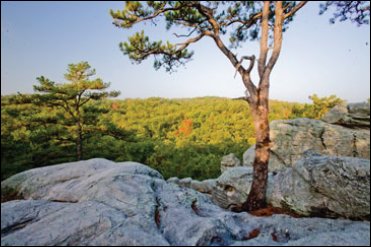Green Horizons
Volume 18, Number 3Fall 2014
Missouri's forests - 12,000 years of change
By MIKE LEAHY
Back 12,000 years ago you wouldn't have had to travel to northern Minnesota or Canada to see a boreal forest, that is a forest type composed of tree species such as spruce, fir, white cedar, jack pine, birch and aspen. The boreal forest was right here in Missouri then, when glaciers covered much of the upper Midwest. Forestry researchers from the University of Missouri-Columbia, Richard Guyette and Mike Stambaugh, have discovered ancient spruce and fir trees exposed along a creek in Putnam County, Missouri. These trees were dated to be about 11,200 years old and were buried under soil and sediments only to be later excavated by stream flooding. Guyette and Stambaugh also found ancient oaks with similar ages indicating that as the glaciers retreated north, temperate hardwood species were beginning to mingle with the spruces and firs as the climate gradually warmed.
 |
Photo courtesy of Eugene L. Brunk |
Likewise, scientists have examined the sediments at the bottom of sinkhole ponds in the Ozarks for their record of preserved pollen grains. This record of ancient pollen grains shows that the Missouri Ozarks were covered by spruce and fir forests from 18,000 to 12,000 years ago. By 8,500 years ago, the climate of Missouri had become warmer and drier than current conditions and much different than the cool moist conditions after the retreat of the glaciers. During these times the pollen record shows that oaks and hickories became well established in Missouri and that also prairie grasses and wildflowers became abundant. Around 4,500 years ago the climate became more similar to what it is like today. Only in the last 4,000 years or so did shortleaf pine migrate north into Missouri becoming well established in the Ozarks over the last few thousand years.
Today, big-toothed and quaking aspen trees still persist in some places in northern Missouri, at the far south end of the native range of these tree species in the Midwest. Another northern species, northern pin oak or Hill's oak, also exists just in a few spots along the northern tier of counties in Missouri. These species were once more common in Missouri in the post-glacial era and today they are relicts of that cooler period. As with trees, some animal species native to Missouri are considered "glacial relicts" such as the wood frog and the four-toed salamander, which today persist in moist, cool habitats in the Ozarks.
Other species are relicts of the hotter, drier period in Missouri's climatic past, the "hypsithermal" of 8,000-5,000 years ago. During that time period more southwestern species moved into the state. For example, Ashe's juniper is a common juniper species across Texas and parts of Oklahoma. It finds habitat in Missouri today on hot, dry rocky dolomitic limestone outcrops and glade edges along cliffs in southwestern Missouri around the Branson area. Missouri is at the northeast corner of the range for Ashe's juniper. American smoke tree is another species that is at its northern edge of range here in Missouri and again finds its native habitat on dry, rocky and hot glades and woodlands on dolomitic limestone. Tarantulas and scorpions, denizens of glades in Missouri, are animal examples of what could be considered "hypsithermal" relict species.
Missouri's forests continue to change through time, albeit today with modern culture these changes can be quick and dramatic such as the introduction of non-native invasive species such as the emerald ash borer. One thing we can count on is that Missouri's forests will continue to change into the future.